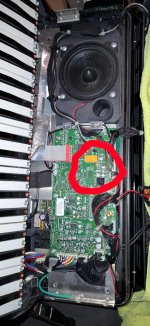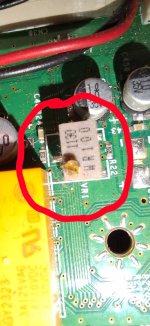A 10 second task completed with pleasure.

Although I certainly had no clue how to solve the audio inequality problem for different bellows direction, despite what some have reported here, commonsense told me that the inequality was too much. To have a difference of about 10 dB in the sound level for equal bellows pressure in either direction is a major problem that I am sure none of you would have accepted if you were to experience it on your own instruments. In fact, looking back on all this I can speculate that perhaps this problem is why I was able to get this instrument for such a bargain price. And now that my instrument is fixed, I can in the end say that someone’s loss turned out to be my gain. I was lucky this time.
It turns out that the FR-7x does have a “Pressure Sensor Calibration Procedure” for equalizing the audio level for each bellows direction. However, it is an adjustment that is normally done by “Roland Product Support” or an “Official Dealer/Repair Facility”. The challenge is one must open the instrument to do it. I had to remove the front grill. In the end, I am very happy that I did, not only because I was able to fix the instrument, but I was able to correct another serious problem that at the time I didn’t even yet know about. But first let me describe the “Pressure Sensor Calibration” that was required.
It turns out that there is a special “TEST MODE” for making a variety of factory instrument adjustments.
To enter this mode:
- · Connect to the FBC-7 pedal unit and turn it on.
- · Turn on the FR-7x while holding down both the treble registers [1] and [3]. Keep the buttons pressed until the “STARTING TEST MODE” appears in the LCD display.
· To exit “TEST MODE” at any time, turn the power off. Note that you must not turn the power off if the message “Do Not Power Off” appears in the display
· “TEST MODE” consists of 21 “Test Items”. The “Pressure Sensor Calibration” item is the third item.
To skip forward to the next “Test Item”, press both the treble registers [13] and [14].
· To return to a previous “Test Item”, press both the treble registers [1] and [2].
So, to verify the “Pressure Sensor Calibration” after first entering “TEST MODE” (be careful not to make any adjustments), you skip forward to the third “Test Item” by pressing the treble registers [13] and [14] twice. The display will report the following:
CALIBRATION
PRESSURE SENSOR: OFFSET Value = XX Calibrate Offset Near to 0
If the “Pressure Sensor Calibration” was properly performed, the “OFFSET Value = XX” will be in the range -9 to +9. At this point you can only inspect the value, not adjust it. So you should now turn the power OFF.
The adjustment screw for "OFFSET Value" is within the instrument and adjustment requires removing the front grill. I was told that if my instrument was still under warranty, removing the front grill would void the warranty. Officially the adjustment is supposed to be done by “Roland Product Support”
On my instrument the "OFFSET Value" was +29. It was completely off and as a consequence in my opinion the instrument was not even playable. Again, I honestly feel that none of you would accept a 10 dB difference in level between bellows directions. A difference of maybe 3 dB might be an acceptable nuisance, but 10 dB is ridiculous.
“Roland Product Support” sent me a document identifying the location of the adjustment screw within the instrument. By removing the front grill before turning the instrument on and carefully resting the grill on the instrument (see attached photo), I was then able to then turn power on, enter “TEST MODE”, step forward to “Test Item #3”, and finally make the adjustment (using a proper
insulated tuning tool of course). The adjustment screw is a multi-turn potentiometer. To adjust the “OFFSET Value” to exactly zero required two full rotations of the screw. That tells you how much it was off. In short, this instrument was NOT properly adjusted at the factory.
A small red circle in the attached photo shows the location of the hole through which I had to pass the adjustment tool in order to turn the potentiometer setting. Every time I turned it, I had to then look over at the display to see the change. After very careful adjustment I was able to adjust “OFFSET Value” to exactly zero.
But here’s the second part to the story. When I tried to remove the front grill, it wouldn't come off. It was stuck. I thought I was missing some secret. I even wrote back to “Roland Product Support” to ask for help. But before they were able to respond, I managed to get it off by pulling hard. And guess why it was stuck? Several wires that interconnect the controls and button on the front grill with the electronics within the frame were jammed between the grill and the housing, wedging the grill tightly in place. The grill had been jammed shut with the wires caught between the grill and the frame by some strong production worker who was possibly thinking too much about sex than with their job. Not only did this make the front grill very difficult to take off, it crammed the wires so tightly that I feel they would have eventually shorted out. After proper adjustment and then turning the instrument off, I replaced the front grill, this time making sure that the interconnecting wires did not get pinched between the front grill and the frame. All it took was a little loving care. If in future I ever have to remove the front grill again, it will come off easily.
FINAL RESULT:Since this is my own instrument, and I am not a production worker thinking about sex (I’m too old for that now), I was able to very carefully adjust the “Pressure Sensor Calibration” for a value of exactly zero. And after turning the instrument off and reassembling it, what a difference it made. It’s like whole new instrument. Now the instrument plays normally with equal audio level in each bellows direction. The difference is amazing. The bellows action is wonderful.Also, the equality of audio level is preserved for different settings of the “Bellows Regulator Control”. I can play with the bellows regulator shut or open. I happen to prefer it to be open somewhat, thus passing a certain amount of air. I understand that some V-Accordionists prefer shutting the “Bellows Regulator Control” completely, and that is fine. I happen to prefer it open to some extent for several
reasons. Now my FR-7xb plays with the very same, wonderful bellows action as my FR-1xb accordion.


